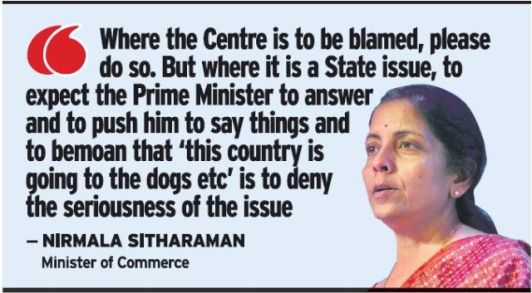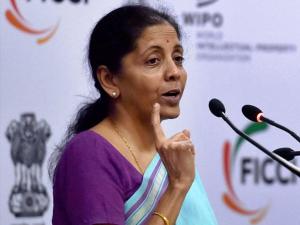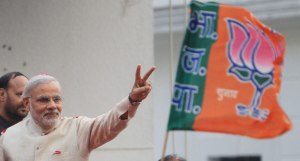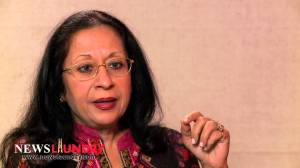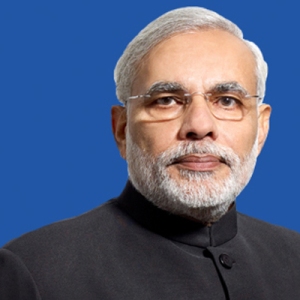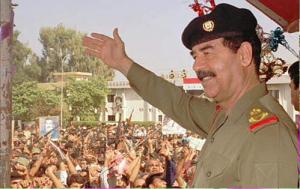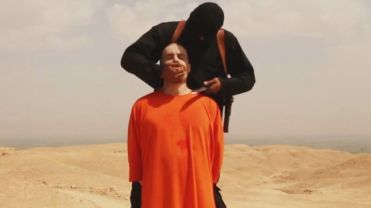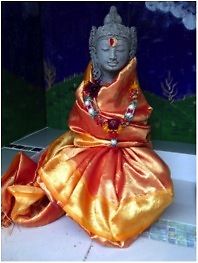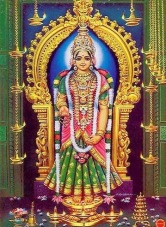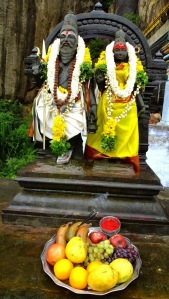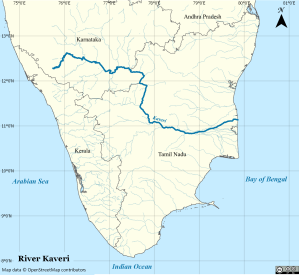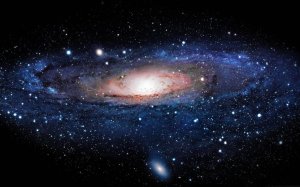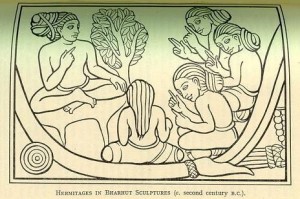

Declaration: This is not my article. This article has been written by Michel Danino who has published it in the undermentioned Journal. I have produced the entire article here for public information. The Aryan Invasion theory is already trashed and consigned to dustbin but, there are some die-hard supporters of this theory who continue to harp on an unfounded belief that people from West Asia came riding on the horses and decimated the ‘bullock-cart’ driving local tribal people! I hope this article will finally make them re-look at their false beliefs.
(Published in the Journal of Indian History and Culture of the C. P. Ramaswami Aiyar Institute of Indological Research, Chennai, September 2006, No.13, pp. 33-59.)
The presence or absence of the horse in the Indus-Sarasvati civilization has been a bone of contention for decades, especially in the context of the Aryan invasion theory. The argument is familiar: the Rig-Veda uses the word ashva over 200 times, ergo the Vedic society must have been full of horses, ergo the Harappan civilization, from which the noble animal is conspicuously absent, must be pre- Vedic and non-Aryan. The horse must therefore have been brought into India around 1500 BCE by the invading Aryans, who used its speed to crushing advantage in order to subdue the native, ox-driven populations. This line of reasoning is regarded as so evident and fool proof that it is taken to be the final word on the issue; as a result, we find it confidently repeated in reference books
and history textbooks dealing with India’s prehistory.
However, on closer view, there are serious flaws at every step of the argument — and indeed several concealed steps. I will first examine the physical evidence of the horse from various Harappan sites, both in terms of skeletal remains and depictions, before turning to problems of methodology that have compounded the confusion, in particular the double-edged use of negative evidence, and the persisting colonial misreading of the Rig-Veda.
Physical remains of the horse in Indus-Sarasvati sites
Our first surprise is that contrary to conventional assertions, quite a few archaeologists have reported horse remains from India’s prehistoric sites. A. Ghosh’s respected and authoritative Encyclopaedia of Indian Archaeology mentions without fuss:
In India the … true horse is reported from the Neolithic levels at Kodekal [dist. Gulbarga of Karnataka] and Hallur [dist. Raichur of Karnataka] and the late Harappa levels at Mohenjo-Daro (Sewell and Guha, 1931) and Ropar and at Harappa, Lothal and numerous other sites. … Recently bones of Equus caballus have also been reported from the proto-Harappa site of
Malvan in Gujarat.1
Mortimer Wheeler, a flamboyant proponent of the Aryan invasion theory if ever there was one, admitted long ago that “it is likely enough that camel, horse and ass were in fact a familiar feature of the Indus caravan.”2 The well- known archaeologist B. B. Lal refers to a number of horse teeth and bones reported from Kalibangan, Ropar, Malvan and Lothal.3 Another senior archaeologist, S. P. Gupta, adds further details on those finds, including early ones.4 In the case of Lothal, the archaeo-zoologist Bhola Nath certified the identification of a tooth; 5 he also made similar observations regarding bones from Mohenjo-Daro and Harappa.6
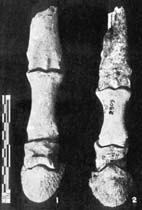
Fig. 1: Horse bones from Surkotada (in Katchchh)
A. K. Sharma’s well-known identification of horse remains (Fig. 1) at Surkotada (in Katchchh) was endorsed by the late Hungarian archaeo-zoologist Sándor Bökönyi, an internationally respected authority in the field; in 1991, taking care to distinguish them from those of the local wild ass (khur), he confirmed several of them to be “remnants of true horses,”7 and what is more, domesticated horses. In his 1993 report to the Director-General of the Archaeological Survey of India, Bökönyi made no bones about the whole issue:
Through a thorough study of the equid remains of the prehistoric settlement of Surkotada, Kutch, excavated under the direction of Dr. J. P. Joshi, I can state the following: The occurrence of true horse (Equus caballus L.) was evidenced by the enamel pattern of the upper and lower cheek and teeth and by the size and form of incisors and phalanges (toe bones). Since no wild horses lived in India in post-Pleistocene times, the domestic nature of the Surkotada horses is undoubtful. This is also supported by an inter- maxilla fragment whose incisor tooth shows clear signs of crib biting, a bad habit only existing among domestic horses which are not extensively used for war.8
Quite in tune with the findings at Surkotada and Lothal, P. K. Thomas, P. P. Joglekar et al., experts from the Deccan College on faunal remains, reported horse bones from the nearby Harappan site of Shikarpur “in the Mature Harappan period,”9 and from Kuntasi (at the boundary between Kutch and Saurashtra).10
To the Neolithic sites mentioned by A. Ghosh, we must add Koldihwa (in the Belan valley of Allahabad district), where G. R. Sharma et al. identified horse fossils.11 Contemporary with the Harappan period, the culture of the Chambal valley (in Madhya Pradesh) was explored by the respected archaeologist M. K. Dhavalikar, with layers dated between 2450 and 2000 BCE.
His observations are remarkable:
The most interesting is the discovery of bones of horse from the Kayatha levels and a terracotta figurine of a mare. It is the domesticate species (Equus caballus), which takes back the antiquity of the steed in India to the latter half of the third millennium BC. The presence of horse at Kayatha in all the chalcolithic levels assumes great significance in the light of the controversy about the horse.12
Let us stress that just as at Surkotada, the horse at Kayatha was domesticated.
In the face of so many reports from so many sites by so many experts, a blanket denial of the animal’s physical presence in pre-1500 BCE India passes one’s comprehension. Are we to believe that all identifications of horse remains by experts are wrong and misleading? Have scholars rejecting such evidence personally crosschecked even 10% of it? Have they, too, expressed similar doubts about the identification of other animal remains found in the same sites and conditions?
Richard Meadow and Ajita Patel did challenge Sándor Bökönyi’s report to the Archaeological Survey.13 Bökönyi however stuck to his views (although he passed away before he could give his final response), and Meadow and Patel concluded their long plea with the rather weak statement that “… in the end that [Bökönyi’s identification of horse remains at Surkotada] may be a matter of emphasis and opinion.”14 What makes their eagerness to convince Bökönyi to change his mind suspect is that they never challenged Indian experts such as A. K. Sharma, P. K. Thomas or P. P. Joglekar; it was only when Bökönyi endorsed findings on the “Harappan horse” that they got alarmed. Since then, amusingly, their inconclusive paper has been quoted by several Marxist15 historians as the last word on the nonexistence of the horse in the Indus- Sarasvati civilization. 16. Even more ironically, when invasionists attempt to trace the introduction of the horse into Europe, they turn to the same Bökönyi! 17 His expertise was never in question in Europe, but is unacceptable in India.
The old argument that so-called horse remains invariably belong to species of wild ass such as the onager (Equus hemionus onager), the khur (Equus hemionus khur), or the plain ass (Equus asinus) is unacceptable, firstly because it is sweeping in nature and produces little or no evidence, secondly because in several cases, experts have simultaneously reported remains of the wild ass from the very same sites, which implies some ability to distinguish between those species.18
Another frequent and sweeping objection is that the dates of the disputed horse remains are not firmly established and might be much more recent. But Jagat Pati Joshi’s excavation report, for instance, makes it clear that,
At Surkotada from all the three periods quite a good number of bones of horse (Equus Caballus Linn) … have been recovered. The parts recovered are very distinctive bones: first, second and third phalanges and few vertebrae fragments.19
The first of Surkotada’s “three periods” coincides with the mature stage of the Harappan civilization, 20 which rules out the possibility of the horse having been introduced by Aryans around 1500 BCE. Moreover, we have the case of Mahagara (near Allahabad), where horse bones were not only identified by G. R. Sharma et al., but “six sample absolute carbon 14 tests have given dates ranging from 2265 B.C.E. to 1480 B.C.E.”21 The case of Hallur, mentioned by A. Ghosh above, is even more striking: the excavation (in the late 1960s) brought out horse remains that were dated between 1500 and 1300 BCE, in other words, about the time Aryans are pictured to have galloped down the Khyber pass, some 2,000 north of Hallur.22 Even at a fierce Aryan pace, the animal could hardly have reached Karnataka by that time. When K. R. Alur, an archaeo-zoologist as well as a veterinarian, published his report on the animal remains from the site, he received anxious queries, even protests: there had to be some error regarding those horse bones. A fresh excavation was eventually undertaken some twenty years later — which brought to light more horse bones, and more consternation. Alur saw no reason to alter his original report, and wrote that his critics’ opinion “cannot either deny or alter the find of a scientific fact that the horse was present at Hallur before the (presumed) period of Aryan invasion.”23 The claim that horse finds are undated is therefore disingenuous.
Finally, S. P. Gupta offers a sensible reply to the further objection that horse remains, if at all they are accepted, rarely account for more than 2% of the total animal remains at any site. Pointing out that the same holds true of the camel and elephant (animals undeniably present in Harappan sites), he explains that this low proportion is “simply because these animals are not likely to have been as regularly eaten as cattle, sheep and goats as well as fish whose bones are abundantly found at all Indus-Sarasvati settlements.”24
All in all, the case for the horse’s physical presence in the Indus-Sarasvati civilization is quite overwhelming, and is bound to be further strengthened by evidence yet to come out of thousands of unexplored sites. Archaeologist A. K. Sharma’s conclusion, in a paper that surveyed the “horse evidence” and his own experiences in this regard, is worth quoting:
It is really strange that no notice was taken by archaeologists of these vital findings, and the oft-repeated theory that the true domesticated horse was not known to the Harappans continued to be harped upon, coolly ignoring these findings to help our so-called veteran historians and archaeologists of Wheeler’s generation to formulate and propagate their theory of ‘Aryan invasion of India on horse-back’….25
Depictions of the horse and the spoked wheel
The Harappans certainly built much of their religious symbols around animals, depicting many of them on their seals and tablets, in terracotta figurines, or as pottery motifs. While it is true that the horse does not appear on the Harappan seals (except if we were to accept the conjecture by S. R. Rao26 and a few other scholars that the composite animal represented on thousands of seals as a unicorn actually has a horse’s head), it has been hastily claimed that the animal is never depicted at all.
A horse figurine did emerge at Mohenjo-Daro (Fig. 2), which drew the following comment from E. J. H. Mackay, one of the early excavators at the site:
Perhaps the most interesting of the model animals is one that I personally take to represent a horse. I do not think we need be particularly surprised if it should be proved that the horse existed thus early at Mohenjo-daro.27
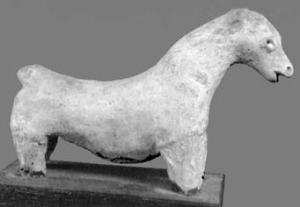
Fig. 2: Horse figurine from Mohenjo-Daro.
Wheeler himself accepted it as such.28 Another figurine was reported by Stuart Piggot from Periano Ghundai, and several at Lothal, some of them with a fairly clear evocation of the horse (Fig. 3 & 4).29 The horse also appears on some pottery, for instance at pre-Harappan levels of Kunal (Haryana), among other animals, according to the excavator R. S. Bisht et al.30 Another figurine was found at Balu, with what looks like a saddle.31 Dhavalikar, quoted above, mentioned “a terracotta figurine of a mare” in the Chambal valley. Finally, the horse is depicted in rock art (for instance at Bhimbetka or Morhana Pahar in the Narmada valley), but unfortunately, we have very few absolute dates for rock
art in India.
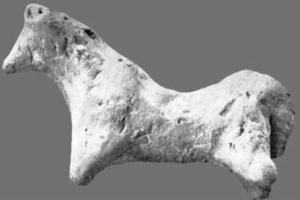
Fig. 3: Horse figurine from Lothal
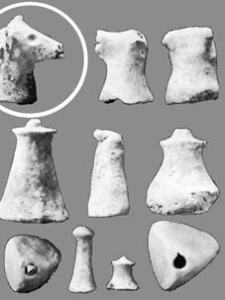
Fig. 4: A horse-like figurine from Lothal (circled, as part of a set of “chessmen”)
It is not just the horse that invasionist scholars sought to erase from pre- 1500 BC India: they also asserted that the spoked wheel came to India only with the Aryans. 32 “The first appearance of [the invading Aryans’] thundering chariots must have stricken the local population with a terror …” writes Michael Witzel in a grandiloquent echo of nineteenth-century racial theories.33 The spoked wheel was thus seen as a crucial element in the speed game, compared to the slow bullock-driven solid-wheeled Harappan cart — until it turned out that Harappans did have spoked wheels, after all. Fig. 5 shows a few terracotta wheels from Banawali and Rakhigarhi where the spokes are clearly visible in relief or painted.34 More such wheels have been found at Kuntasi,35 Lothal, and Bhirrana36 (in Haryana).
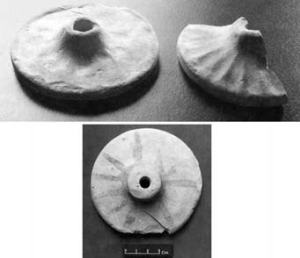
Fig. 5: Terracotta wheels from Banawali and Rakhigarhi, displaying spokes painted or in relief
All this material illustrates the danger of “negative evidence”: it takes very little to make it irrelevant.
Methodological issues
Raw evidence apart, the appearance of the horse in the Indian subcontinent is, in reality, a complex issue, and by treating it crudely, the conventional theory suffers from serious methodological flaws. Let us briefly highlight a few of them.
- Physical remains and depictions of the horse in India after 1500 BC
The invasionist school posits that the horse was introduced into India by the “Aryans” around 1500 BC. One would therefore expect a marked increase in remains and depictions of the animal after that fateful event (or non-event). Yet — and this is one of the best kept secrets of Indian prehistory — nothing of the sort happens.
Looking only at the early historical layers, Taxila, Hastinapur or Atranjikhera (Uttar Pradesh) have indeed yielded bones of both the true horse and the domestic ass (strangely, the distinction between the two is no longer disputed here!), but at other sites, such as Nashik, Nagda (Madhya Pradesh),
Sarnath, Arikamedu (Tamil Nadu), Brahmagiri (Karnataka), Nagarjunakonda (Andhra Pradesh), no remains of either animal have turned up. There are also sites like Jaugada (Orissa) or Maski (Karnataka) where the ass has been found, but not the horse.37 Finally, data available from sites that do come up with horse remains show no significant increase in the overall percentage of horse bones or teeth compared to Harappan sites such as Surkotada.
If, therefore, the low amount of evidence for the horse in the Indus- Sarasvati civilization is taken as proof that that civilization is pre-Vedic, we must extend the same logic to the whole of pre-Mauryan India! It is clear that the horse was as rare or as common an animal before and after 1500 BC — “rare” is probably the correct statement for both.
As regards “post-invasion” depictions of the horse, they are also no more frequent than in Harappan sites: barring a few figurines at Pirak, Hastinapura and Atranjikhera, we find no striking representations of the animal, while we would have expected the aggressive “Aryans” to pay rich tributes to their instrument of conquest, which, invasionists tell us, the Rig-Veda glorifies so much. And yet, “the first deliberate and conscious attempt of shaping a horse in durable material like stone was witnessed in the art of the Mauryas in India,” writes historian T. K. Biswas.38 Another historian, Jayanti Rath, commenting on the animals depicted on early Indian coins, remarks: “The animal world of the punch-marked coins consists of elephant, bull, lion, dog, cat, deer, camel, rhinoceros, rabbit, frog, fish, turtle, ghariyal (fish eater crocodile), scorpion and snake. Among the birds, peacock is very popular. The lion and horse symbols appear to have acquired greater popularity in 3rd century B.C.”39
All in all, an eerie equine silence pervades pre-Mauryan India.
- Physical remains and depictions of the horse outside India
It helps to take a look at a few regions outside India. In contemporary Bactria, for instance, the horse is well documented through depictions in grave goods, yet no horse bones have been found. “This again underscores the point that lack of horse bones does not equal the absence of horse,” writes U.S. Indologist Edwin Bryant.40
In the case of the horse in America, where its spread is fairly well known, Elizabeth Wing points out,
Once safely landed in the New World, they are reported to have prospered along with cattle in the grazing lands, free of competitors and predators. Horse remains, however, are seldom encountered in the archaeological sites. This may be a function of patterns of disposal, in which remains of beasts of burden which were not usually consumed would not be incorporated in food or butchering refuse remains.41
This fits with the picture we have formed of the horse in the Indus- Sarasvati civilization, and with S. P. Gupta’s similar observation on the non- consumption of horse meat. Clearly, invasionists have sought to put too much weight on the rarity of horse remains in the third millennium.
- Introduction of the horse = Aryan invasion?
Another non sequitur is that since the true horse was undoubtedly introduced into India at some time, and probably from Central Asia, it can only have been introduced by invading Aryans.
As we have seen, the horse’s introduction must have taken place right from Mature Harappan times, if not earlier; but let us assume for the sake of argument that it only happened, as invasionist scholars assert without the least evidence, in Late Harappan times. Even if it were so, how would it establish
that the horse came as a result of an invasion or a migration, when other possibilities are equally valid, or more so if we look at the evolution of the region? Bryant, again, puts it crisply:
In the absence of irrefutable linguistic evidence, there is no reason to feel compelled to believe that the introduction of the horse into the subcontinent is indicative of the introduction of new peoples any more than the introduction of any other innovatory items of material culture (such as camels, sorghum, rice, lapis lazuli, or anything else) is representative of new human migratory influxes.42
In other words, at whatever epoch, the horse could have been introduced as an item of trade — and we do know that Harappans had extensive trade contacts with a wide region, from Mesopotamia all the way to northern Afghanistan and possibly parts of Turkmenistan. This is indeed the stand of archaeologists like Jean-François Jarrige or Jonathan M. Kenoyer. The latter, for instance, notes that the adoption of the horse or the camel reflects “changes [that] were made by the indigenous [Late Harappan] inhabitants, and were not the result of a new people streaming into the region. The horse and camel would indicate connections with Central Asia.”43
Whatever the date of the horse’s introduction into the subcontinent might be, there is no ground to assume a “violent” introduction through a war-like conquest.
- The problem of depiction
Regardless of the issue of physical remains, invasionists have persisted, understandably so, in stressing the nagging non-depiction of the horse on Indus seals (conveniently glossing over the figurines mentioned earlier). However, S. P. Gupta points out that the camel, “wolf, cat, deer, Nilgai, fowl, jackal are rarely or never found in [Harappan] art but their presence has been attested by bones.”44 We can add the camel and the lion, which were certainly present in some regions of the Harappan civilization yet were never depicted. The scholar K. D. Sethna pertinently asks, “As there are no depictions of the cow, in contrast to the pictures of the bull, which are abundant, should we conclude that Harappa and Mohenjo-daro had only bulls?”45 Sethna goes further; he makes the opposite point that the mythical unicorn is found on numerous seals, and asks, “Was the unicorn a common animal of the proto-historic Indus Valley?”46 Clearly, animal representations, or their absence, have cultural reasons: the Indus seals were not intended to be zoological handbooks. Until we have a deeper understanding of Harappan culture, we can only conjecture about its iconography.
- Is the Vedic horse the true horse?
Invasionists are usually unaware that they begin by making an important assumption: they take it for granted that the Vedic horse is the true horse, Equus caballus L. Although this might appear self-evident, it is not. In fact, as some scholars have pointed out, the Rig-Veda47 describes the horse as having 34 ribs; so does a passage in the Shatapatha Brahmana.48 However, the true horse generally has two pairs of 18 ribs, i.e. 36 and not 34.
This suggests that the horse referred to in the Rig-Veda may have been a different species, such as the smaller and stockier Siwalik or Przewalski horses, which often (not always) had 34 ribs. The scholar Paul Manansala, who stressed this point, concluded: “So the horse of India, including that of the asvamedha sacrifice in what is regarded as the oldest part of the Rgveda, is a distinct variety native to southeastern Asia.”49
The question is far from solved, as experts in the field do not always see eye to eye, but it also cannot be wished away.
- Meaning of ‘ashva’ in the Rig-Veda
We now come to a more fundamental point. After the nineteenth-century European Sanskritists, most scholars have taken it for granted that Vedic society should be full of horses because of the frequent occurrence of ashva in the Rig- Veda. This conclusion is flawed on two grounds.
First, because the language of the Rig-Veda is a symbolic one that constantly operates at different levels. Else, how could we explain powerful images with no possible ritualistic or “animist” explanation, such as a lower and an upper ocean,50 a “wave of honey” rising from the ocean,51 “rivers of ghee rising in the ocean of the heart,”52 a “well of honey” hidden under the rock,53 “a divine fire born of waters,54 present in the stone”,55 or compared to “a child that gave birth to its own mothers”,56 an “eighth sun, hidden in darkness”,57 and dozens more? A purely materialistic or ritualistic reading of the Rig-Veda is bound to fail us at every step, and is unjustified when other mythologies, from the Babylonian to the Egyptian and the Greek, have long been explored at deeper figurative and symbolic levels. It is strange how most scholars, hypnotized by colonial misinterpretations, have failed to follow the Rig-Veda’s own clue: “Secret words that reveal their meaning [only] to the seer.”58
So let us turn to one such “seer.” As early as 1912-14, a decade before the discovery of the Indus-Sarasvati civilization, and thus long before our “Harappan horse” controversy, Sri Aurobindo in his study of the Rig-Veda and the Upanishads found that
‘The word ‘ashva’ must originally have implied strength or speed or both before it came to be applied to a horse’.59
More specifically,
The cow and horse, ‘gao’ and ‘ashva’, are constantly associated. Usha, the Dawn, is described as gomati ashvavati; Dawn gives to the sacrificer horses and cows. As applied to the physical dawn gomati means accompanied by or bringing the rays of light and is an image of the dawn of illumination in the human mind. Therefore ashvavati also cannot refer merely to the physical steed; it must have a psychological significance as well. A study of the Vedic horse led me to the conclusion that go and ashva represent the two companion ideas of Light and Energy, Consciousness and Force….60
For the ritualist the word go means simply a physical cow and nothing else, just as its companion word, ashva, means simply a physical horse…. When the Rishi prays to the Dawn, gomad viravad dhehi ratnam uso ashvavat, the ritualistic commentator sees in the invocation only an entreaty for “pleasant wealth to which are attached cows, men (or sons) and horses”. If on the other hand these words are symbolic, the sense will run, “Confirm in us a state of bliss full of light, of conquering energy and of force of vitality.”61
In other words, Sri Aurobindo rejects a mechanical equation, ashva = horse.
The constant association of the Vedic horse with waters and the ocean, from the Rig-Veda to the Puranic myth of the churning of the ocean, confirms that we are not dealing here with an ordinary animal, as does the depiction of the Ashvins as birds. Within this framework, the ashvamedha sacrifice also deserves a new treatment, which the Indologist Subhash Kak has recently outlined very cogently.62
Sri Aurobindo’s stand received indirect support from a wholly different angle, that of the late anthropologist Edmund Leach, who warned against the picture of a horse-rich Rig-Vedic society:
The prominent place given to horses and chariots in the Rig Veda can tell us virtually nothing that might distinguish any real society for which the Rig Veda might provide a partial cosmology. If anything, it suggests that in real society (as opposed to its mythological counterpart), horses and chariots were a rarity, ownership of which was a mark of aristocratic or kingly distinction.63
Thus the place of the horse in the Rig-Veda needs to be reassessed from a decolonized standpoint, with a fresh look at the Vedic message and experience. If Sri Aurobindo and Leach are both right, then the word ashva refers only occasionally to the actual animal, and its rarity is well reflected in the modest amount of physical remains and depictions. Indeed, even in today’s India, despite having been imported into India for many centuries, the horse remains a relatively rare animal, invisible in most villages.
At this point, a valid objection could be raised: if the horse did exist in the Indus-Sarasvati civilization, and if one wishes to equate this civilization with Vedic culture,64 the latter at least makes a symbolic use of the animal; why is the horse therefore not depicted more often as a symbol in Harappan art, for instance on the Indus seals? The answer I propose is simple: even if the Rig- Veda is contemporary with, or older than, the mature Indus-Sarasvati civilization, we need not expect Harappan art to be a pure reflection of Vedic concepts. The Veda represents the very specific quest of a few rishis, who are unlikely to have lived in the middle of the Harappan towns. Although Vedic concepts and symbols are visible in Harappan culture, the latter is a popular culture; in the same way, the culture of today’s Indian village need not exactly reflect Chennai’s music and dance sabhas. Between Kalibangan’s peasant sacrificing a goat for good rains and the rishi in quest of Tat ekam, That One, there is a substantial difference, even if they ultimately share the same worldview.
Only a more subtle approach to Harappan and Vedic cultures can throw light on their apparent differences.
- Is ashva only Aryan?
One more unstated assumption of invasionists, who trust that their readers will not go and check the original text, is that ashva, in the Rig-Veda, is a purely Aryan animal. But is that what the text actually says? No doubt, most of the references place ashva, whatever the word means in the Rishis’ mind, squarely on the side of the Aryan gods and their human helpers. But it turns out that there are a few revealing exceptions, when Dasyus and Panis also possess ashvas.
For instance, Indra-Soma, by means of the truth (eva satyam), shatters the stable where Dasyus were holding “horses and cows” (ashvyam goh).65 In another hymn, Indra’s human helpers find the Pani’s “horses and cattle”: “The Angirasas gained the whole enjoyment of the Pani, its herds of the cows and the horses.”66
The most striking passage67 is from the famous dialogue between the divine hound Sarama, Indra’s intransigent emissary, and the Panis, after she has discovered their faraway den, where they jealously hoard their “treasures.” Sarama boldly declares Indra’s intention to seize these treasures, but the Panis are unimpressed and threaten to fight back; they taunt her: “O Sarama, see the treasure deep in the mountain, it is full of cows and horses and treasures (gobhir ashvebhir vasubhir nyrsah). The Panis guard it watchfully. You have come in vain to a rich dwelling.” Every verse makes it clear that all these treasures, horses included, belong to the Panis; at no point does Sarama complain that these are stolen goods: “I come in search of your great treasures,”68 she declares at first, and the Panis would not be insolent enough to taunt her with goods seized from the Aryans; yet Sarama considers that Indra is fully entitled to them.
Now, if we followed the same colonial reading that invasionists impose on the Vedas, we would be forced to acknowledge that the Dasyus and Panis also had horses of their own — which of course negates the whole idea of the animal having been introduced by the Aryans. It does look as if this Vedic landscape is getting a little too crowded with horses, rather like a cheap Hollywood western.
To understand the Dasyus’ and Panis’ “horses,” we need to return to the Vedic symbolism proposed by Sri Aurobindo: the demons do possess lights (cows) and energies or powers (horses), but, as misers, keep them for themselves, neither for the gods nor for man. In the Vedic view, this is a transgression of the cosmic law. The duty of the rishi, helped by the gods, is to reconquer those “treasures” and put them to their true purpose; only then will the cosmic order be reestablished. This is certainly more interesting than the tribal clashes of a barbaric and primitive age. In fact, the Rig-Veda itself makes its symbolism clear again and again, if only we can learn to read it with an open mind. In the last verse69 of the dialogue between Sarama and the Panis, for instance, the narrator concludes, “Go away, you Panis! Let out the cows which, hidden, infringe the Order!” This “order” is ritam, the true cosmic law. It is infringed not because the Panis hide a few cows and horses inside a cave, but because they misuse their lights and powers and do not offer them up as a sacrifice. That is why Indra is entitled to their treasures — not because he is a greedy tribal leader out to expand his territory and wealth; and that is why he can shatter the demons’ dens only “by means of the truth.”
Had it not been for the Aryan invasion theory, the Rig-Veda would have long ago been the object of interpretations on a level with that accorded to Greek or Egyptian mythology, instead of being constricted to a literalist reading.
Conclusions
That the invasionist scholars should have skirted such important issues, as regards both findings and methodology, does little to inspire confidence. Clearly, the whole question of the Vedic and Harappan horse has been treated simplistically. To sum up:
- Several species of Equus, including the true horse, existed in the Indus- Sarasvati civilization, probably in small numbers. Some of them may have entered India over a much longer time span than is usually granted, in the course of the Indus-Sarasvati civilization’s interactions with neighbouring areas, but certainly not through any Aryan invasion or migration, which in any case has already been rejected by archaeological, anthropological, genetic, literary and cultural evidence.70
- This process continued with a gradual but slight increase after the end of the mature phase of the Indus-Sarasvati civilization right up to early historical times. There was no epoch exhibiting a sudden, first-time introduction of the animal.
- The Rig-Veda has been misread; it tells us strictly nothing about a sizeable horse population, and rather suggests its rarity. The animal was important in symbolic, not quantitative terms.
- The Rig-Veda also tells us nothing about conquering Aryans hurtling down from Afghanistan in their horse-drawn “thundering” chariots and crushing indigenous tribal populations; it is high time we abandoned once and for all those perverse fancies of nineteenth-century scholars, even if some of their peers hang on to such myths even today.
The hypothesis I have put forward is testable: if correct, we should expect further excavations of Harappan sites to come up with more horse remains and depictions, although nothing on the scale that the Aryan invasion theory wrongly expects of a Vedic society — and has failed to document in post-
Harappan India.
Acknowledgements
I am much indebted to Shri Vishal Agarwal for generously sharing his unpublished research on the topic; some of the data on horse remains in protohistoric and historical periods are borrowed from his work, and his advice on other points was very helpful.
* * *
References & Notes
1
A. Ghosh, An Encyclopaedia of Indian Archaeology (New Delhi: Munshiram Manoharlal, 1989),
vol. 1, p. 4.
2
Mortimer Wheeler, The Indus Civilization (Cambridge: Cambridge University Press, 1953), p.
92, quoted by Edwin Bryant in The Quest for the Origins of Vedic Culture: The Indo-Aryan
Migration Debate (New Delhi: Oxford University Press, 2002), pp. 170-171.
3
B. B. Lal, The Earliest Civilization of South Asia (New Delhi: Aryan Books International, 1997),
p. 162.
4
S. P. Gupta, The Indus-Sarasvati Civilization – Origins, Problems and Issues (Delhi: Pratibha
Prakashan, 1996), pp. 160-161.
5
Quoted in S. R. Rao, Lothal – A Harappan Port Town (New Delhi: Archaeological Survey of
India, 1985), vol. II, pp. 641-642.
6
For Harappa, see Bhola Nath, “Remains of the Horse and the Indian Elephant from the
Prehistoric Site of Harappa (West Pakistan)” in Proceedings of the All-India Congress of Zoology
(Calcutta: Zoological Society of India, 1961). See also Bhola Nath, “Advances in the Study of
Prehistoric and Ancient Animal Remains in India – A Review” in Records of the Zoological
Survey of India, LXI.1-2, 1963, pp. 1-64.
7
Sándor Bökönyi, “Horse Remains from the Prehistoric Site of Surkotada, Kutch, Late 3rd
Millennium B.C.,” South Asian Studies, vol. 13, 1997 (New Delhi: Oxford & IBH), p. 299.
8
Sándor Bökönyi, 13 December 1993, in his report to the Director General of the
Archaeological Survey of India, quoted by B. B. Lal in The Earliest Civilization of South Asia,
op. cit., p. 162.
The Horse and the Aryan Debate / p. 18
9
P. K. Thomas, P. P. Joglekar, et al, “Harappan Subsistence Patterns with Special Reference to
Shikarpur, a Harappan Site in Gujarat,” Man and Environment XX (2) – 1995, p. 39.
10
P. K. Thomas, P. P. Joglekar, et al, “Subsistence Based on Animals in the Harappan Culture
of Gujarat,” Anthropozoologica, 1997, N°25-26, p. 769.
11
G. R. Sharma, History to Prehistory: Archaeology of the Vindhyas and the Ganga Valley
(University of Allahabad, 1980), quoted by K. D. Sethna, The Problem of Aryan Origins, p. 220-
221.
12
M. K. Dhavalikar, Indian Protohistory (New Delhi: Books & Books, 1997), p. 115.
13
Richard Meadow & Ajita Patel, “A Comment on ‘Horse Remains from Surkotada’ by Sándor
Bökönyi,” South Asian Studies, vol. 13, 1997 (New Delhi: Oxford & IBH), pp. 308-315.
14
Ibid., p. 314.
15
I use the word “Marxist” not in any derogatory manner, but in the way those historians and
scholars use it to describe their own school of thought. D. D. Kossambi’s Introduction to the
Study of Indian History (1956) set the tone, declaring its intent to use “dialectical materialism,
also called Marxism” to read the evolution of Indian society, complete with a “proletariat”
and class war. My use of the term “Marxist” is the same as Romila Thapar in her Penguin
History of Early India: From the Origins to AD 1300 (New Delhi: Penguin Books, 2003), p. 22 ff.
16
For instance Ram Sharan Sharma, “Was the Harappan Culture Vedic?”, Journal of
Interdisciplinary Studies in History and Archaeology (University of Allahabad), 1:2, Winter 2004,
pp. 135-144. See also Romila Thapar Penguin History of Early India, op. cit., p. 85 (although she
does not specifically refer to Meadow’s and Patel’s paper, the context makes it clear).
17
For instance, J. P. Mallory, In Search of the Indo-European: Language, Archaeology and Myth
(London: Thames and Hudson, 1989), p. 273, note 8; Bernard Sergent, Les Indo-Européens:
Histoire, langues, mythes (Payot, 1995), p. 397.
18
This is the case at Surkotada. See Jagat Pati Joshi, Excavation at Surkotada and Exploration in
Kutch (New Delhi: Archaeological Survey of India, Memoirs N°87, 1990), pp. 381-382.
19
Ibid., p. 381.
20
Period IA starts about 2300 BCE (see ibid., p. 60 ff.), but this is based on uncalibrated C-14
analysis; a calibrated date will usually be a few centuries older, which would fit well with
the now accepted date of 2600 BCE for the start of the mature Harappan phase.
21
G. R. Sharma et al., Beginnings of Agriculture (Allahabad: Abinash Prakashan, 1980), pp. 220-
221, quoted by Edwin Bryant in The Quest for the Origins of Vedic Culture, op. cit., p. 170.
22
K. R. Alur, “Animal Remains” in Proto-historical Cultures of the Tungabhadra Valley, ed. M. S.
Nagaraja Rao (Dharwad: Rao, 1971). Note that here too, the dates are most likely
uncalibrated and therefore to be pushed back a few centuries.
23
K. R. Alur, “Aryan Invasion of India, Indo-Gangetic Valley Cultures,” in New Trends in
Indian Art and Archaeology, ed. B. U. Nayak & N. C. Ghosh (New Delhi: Aditya Prakashan,
1992), p. 562, quoted by Edwin Bryant, The Quest for the Origins of Vedic Culture: The Indo-
Aryan Migration Debate (New York: Oxford University Press, 2001), p. 170 and by A. K.
Sharma, “The Harappan Horse was buried under the dunes of …”, Puratattva, No. 23, 1992-
93, p. 30.
24
S. P. Gupta, The Indus-Sarasvati Civilization – Origins, Problems and Issues, op. cit., p. 162.
25
A. K. Sharma, “The Harappan Horse was buried under the dunes of …” in Puratattva, N°23
(1992-93), p. 31.
26
S. R. Rao, Dawn and Devolution of the Indus Civilization (New Delhi: Aditya Prakashan, 1991),
p. 196 & 299.
The Horse and the Aryan Debate / p. 19
27
E. J. H. Mackay, Further Excavations at Mohenjo-daro (Delhi: Government of India, 1938), vol.
I, p. 289.
28
Quoted by B. B. Lal in India 1947-1997: New Light on the Indus Civilization (New Delhi: Aryan
Books International, 1998), p. 109.
29
The set of chessmen is taken from S. R. Rao, Dawn and Devolution of the Indus Civilization, op.
cit., detail of plate N°120. I suggest the following test to anyone who doubt that this figurine
represents a horse: show the whole set of “chessmen” to schoolchildren and ask them what
it is; the answer will always be, “Chess!” (This, at least, has been my own experience.) Then
as, “Why?” The reply: “Because of the horse.” I suggest that children’s sense of observation
in such a case is more reliable and less biased than even that of “experts,” all the more so as
many of the Harappan figurines were very likely toys for children.
30
R. S. Bisht, C. Dorje, Arundhati Banerji, eds. Indian Archaeology 1993-94 – A Review,
Explorations and Excavations (New Delhi: Director General Archaeological Survey of India,
2000), p. 49.
31
See K. D. Sethna, The Problem of Aryan Origins (New Delhi: Aditya Prakashan, 2nd ed., 1992),
pp. 419-420.
32
See for instance Romila Thapar, Cultural Pasts (Delhi: Oxford University Press, 2000), p.
1131.
33
Michael Witzel, “Early Indian history: Linguistic and textual parametres,” in The Indo-
Aryans of Ancient South Asia: Language, Material Culture and Ethnicity, ed. George Erdosy
(Berlin & New York: Walter de Gruyter, 1995), p. 114.
34
Both pictures are taken from B. B. Lal, The Sarasvati Flows On: the Continuity of Indian
Culture (New Delhi: Aryan Books International, 2002), p. 74.
35
M. K. Dhavalikar, Indian Protohistory, op. cit., p. 297.
36
L. S. Rao, “The Harappan Spoked Wheels Rattled Down the Streets of Bhirrana, Dist.
Fatehabad, Haryana,” in Puratattva No. 36, 2005-06, pp. 59-67.
37
Bhola Nath, “Advances in the Study of Prehistoric and Ancient Animal Remains in India – A
Review” in Records of the Zoological Survey of India, LXI.1-2, 1963, pp. 1-64.
38
T. K. Biswas, Horse in Early Indian Art (New Delhi: Munshiram Manoharlal, 1987), p. 46.
39
Jayanti Rath, “The Animal Motifs On Indian Coins (Ancient And Mediaeval Period)” in
Orissa Historical Research Journal, vol. XLVII, No. 1, p. 57.
40
Edwin Bryant, The Quest for the Origins of Vedic Culture (New York: Oxford University Press,
2001), p. 175.
41
Elizabeth S. Wing, “Impact of Spanish Animal Uses in New World,” pp. 72-79 in Juliet
Clutton-Brock, ed., The Walking Larder – Patterns of Domestication, Pastoralism, and Predation
(London: Unwin Hyman, 1989), p. 78.
42
Edwin Bryant, The Quest for the Origins of Vedic Culture, op. cit., p. 228.
43
Jonathan M. Kenoyer, “Interaction Systems, Specialized Crafts And Cultural Change,” in
The Indo-Aryans of Ancient South Asia, ed. George Erdosy (Berlin & New York: Walter de
Gruyter, 1995), p. 227.
44
S. P. Gupta, The Indus-Saraswati Civilization, op. cit., p. 162.
45
K. D. Sethna, The Problem of Aryan Origins (New Delhi: Aditya Prakashan, 2nd ed., 1992),
p. 179.
46
K. D. Sethna, The Problem of Aryan Origins, p. 179.
47
Rig-Veda, I.162.18.
48
Shatapatha Brahmana, 13.5.
The Horse and the Aryan Debate / p. 20
49
Paul Kekai Manansala, “A New Look at Vedic India,” published and circulated over the
Internet (http://asiapacificuniverse.com/pkm/vedicindia.html).
50
Rig-Veda, VII.6.7. (All translations from the Rig-Veda are adapted from Sri Aurobindo’s.)
51
IV.58.1.
52
IV.58.5.
53
II.24.4.
54
III.1.3.
55
I.70.2
56
I.95.4.
57
III.39.5, X.72.9.
58
IV.3.16.
59
Sri Aurobindo, The Upanishads (Pondicherry: Sri Aurobindo Birth Centenary Library, vol. 12,
1972), p. 400-401.
60
Sri Aurobindo, The Secret of the Veda (Pondicherry: Sri Aurobindo Birth Centenary Library,
vol. 10, 1972), p. 42.
61
Ibid., p. 118.
62
Subhash Kak, The Asvamedha: the Rite and its Logic (Delhi: Motilal Banarsidass, 2002).
63
Edmund Leach: “Aryan invasions over the millennia” in Culture Through Time:
Anthropological Approaches, ed. Emiko Ohnuki-Tierney (Stanford: Stanford University Press,
1990), p. 240.
64
See a number of parallels between Harappan and Vedic cultures, as well as historical
survivals of Harappan cultures in Michel Danino, “The Harappan Heritage and the Aryan
Problem,” Man and Environment (Pune), XXVIII.1, January-June 2003, pp. 21-32.
65
Rig-Veda, IV.28.5.
66
I.83.4.
67
X.108.7. I have freely adapted here the French translation of the hymn provided in Le Véda,
ed. Jean Varenne (Paris: Les Deux Océans, 1967), p. 152-53.
68
X.108.2.
69
X.108.11.
70
For a study of the Aryan invasion theory, see Edwin Bryant, The Quest for the Origins of Vedic
Culture, op. cit.; Koenraad Elst, Update on the Aryan Invasion Debate (New Delhi: Aditya
Prakashan, 1999); Michel Danino, L’Inde et l’invasion de nulle part (Paris: Les Belles Lettres,
2006).
The question is far from solved, as experts in the field do not always see eye to eye, but it also cannot be wished away.



